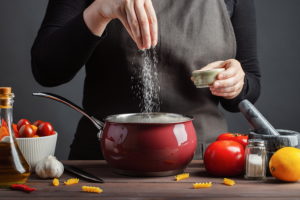Five Essential Rules of Cooking
go.ncsu.edu/readext?665701
en Español / em Português
El inglés es el idioma de control de esta página. En la medida en que haya algún conflicto entre la traducción al inglés y la traducción, el inglés prevalece.
Al hacer clic en el enlace de traducción se activa un servicio de traducción gratuito para convertir la página al español. Al igual que con cualquier traducción por Internet, la conversión no es sensible al contexto y puede que no traduzca el texto en su significado original. NC State Extension no garantiza la exactitud del texto traducido. Por favor, tenga en cuenta que algunas aplicaciones y/o servicios pueden no funcionar como se espera cuando se traducen.
Português
Inglês é o idioma de controle desta página. Na medida que haja algum conflito entre o texto original em Inglês e a tradução, o Inglês prevalece.
Ao clicar no link de tradução, um serviço gratuito de tradução será ativado para converter a página para o Português. Como em qualquer tradução pela internet, a conversão não é sensivel ao contexto e pode não ocorrer a tradução para o significado orginal. O serviço de Extensão da Carolina do Norte (NC State Extension) não garante a exatidão do texto traduzido. Por favor, observe que algumas funções ou serviços podem não funcionar como esperado após a tradução.
English
English is the controlling language of this page. To the extent there is any conflict between the English text and the translation, English controls.
Clicking on the translation link activates a free translation service to convert the page to Spanish. As with any Internet translation, the conversion is not context-sensitive and may not translate the text to its original meaning. NC State Extension does not guarantee the accuracy of the translated text. Please note that some applications and/or services may not function as expected when translated.
Collapse ▲5 Essential Rules of Cooking
- Have a good knife and cutting board. Having 1 or 2 good knives is important. One of these should be a chef’s knife. This is the workhorse in your kitchen. Just as important is a good cutting board. If you do not have a cutting board with a non-skid back, place a wet paper towel under it to keep it from slipping. Now for the ESSENTIAL part – learn to use your knives. Check out our knife skills videos to get you started. Practice, practice, practice. The more you practice good knife skills the better (and faster) you will become. Having good knife skills will make all of your recipes come together faster.
- Ready your space and your ingredients. Before you start to cook anything, clear and clean your space if it is not already. This reminds me of something a chef I once trained under told me – you clean the kitchen until it shines not for how you feel leaving the kitchen but for how you will feel walking into the kitchen the next morning. You really need a clear clean space to be able to be
 your best as a cook. Ready all of your ingredients. Pull them out of the pantry, refrigerator, or freezer. Chop or prep as needed. This is called mise en place– or put in place – it is how every commercial kitchen is run. Learning from the pros will make you a better home cook.
your best as a cook. Ready all of your ingredients. Pull them out of the pantry, refrigerator, or freezer. Chop or prep as needed. This is called mise en place– or put in place – it is how every commercial kitchen is run. Learning from the pros will make you a better home cook. - Cook a lot. You may think this essential rule is about cooking all the time – nope. It is about cooking more food than you need for each meal. Cook a lot – volume. Double that soup recipe and freeze two quarts. Make extra roasted vegetables and use them in salads, in omelets, as a snack. Cooking twice as much as you need does not take double time and you will have planned-overs for other meals or the freezer. I like nothing better than thinking about my week of meals and realizing that I have a quart of butternut squash soup in the freezer – there is one meal with no work.
- Cook with ingredients not only recipes. This is a hard one for beginning cooks but the more you can be driven in your cooking by ingredients as opposed to recipes the better. Recipes are great, we all use them – keep that up. However, let the ingredients drive your cooking instead of the recipes. Let’s say you decide to make a recipe that calls for asparagus, you go to the store and buy sub-par asparagus that doesn’t look great and it is not on sale. You are letting your recipe drive your cooking as opposed to buying the Napa cabbage that looks fresh and is on special then deciding what to do with that. Try this for at least one fruit or vegetable each week and soon it will become second nature.
- Find YOUR food. Find 5-10 recipes you like, your family likes, and you enjoy making. Make them all the time. Making a dish over and over will make it get easier. Think about the first time you made a dish that you now make all the time. I guarantee that it is easier and quicker now. It is ok to have even a small number of dishes that you make over and over. Making something multiple times also allows you to change the recipe if you like based on the season or what you have on hand.


